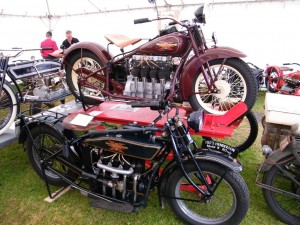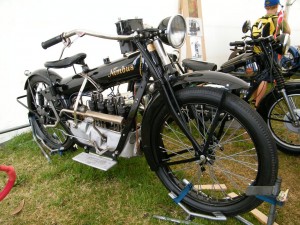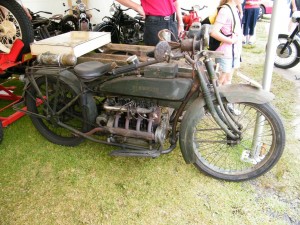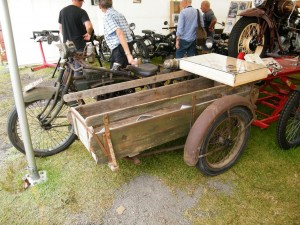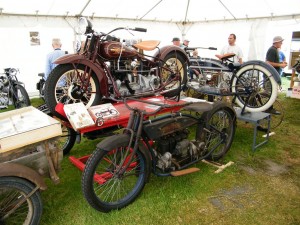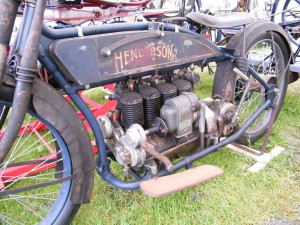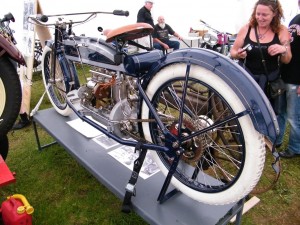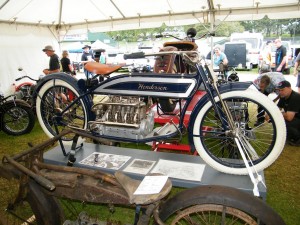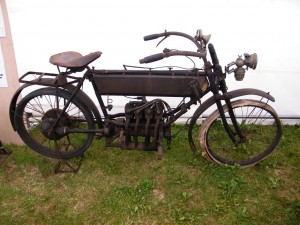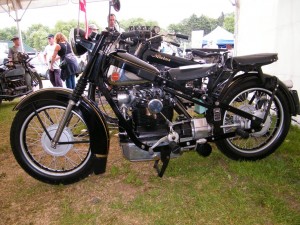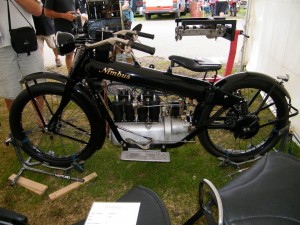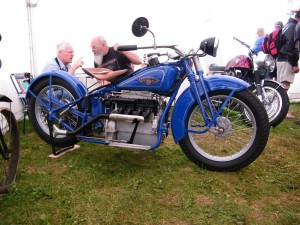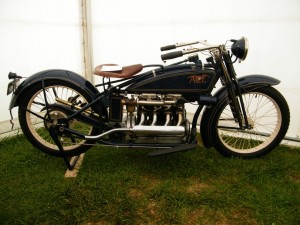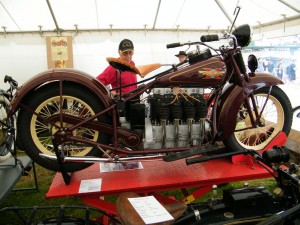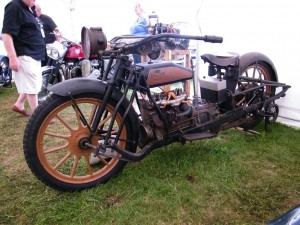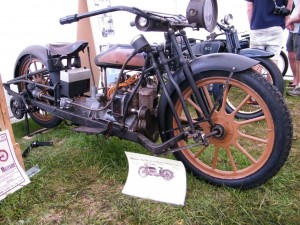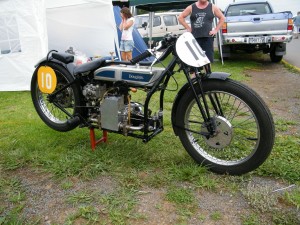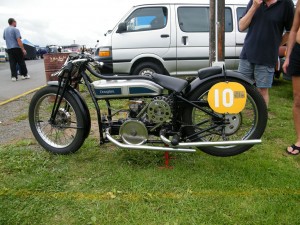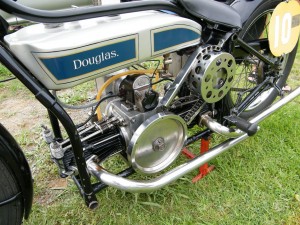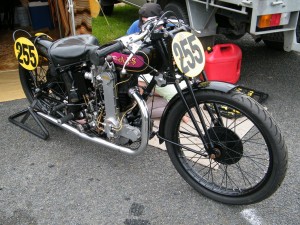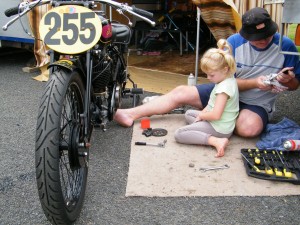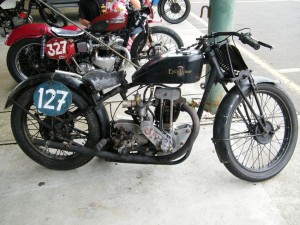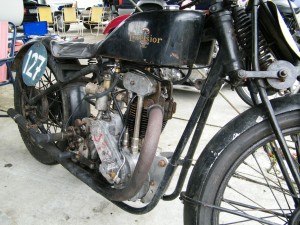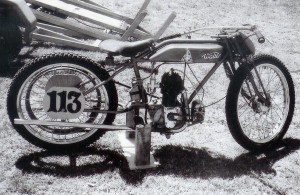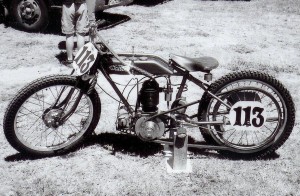For a small country like New Zealand we are definitely blessed with some of the finest motorcycling machinery in the world. And one of the places to see such machines is the Classic Racing Registers Festival held over the weekend of February 4th, 5th, and 6th at the Pukekohe Park Raceway in South Auckland. Every year there is something well worth seeing, whether it be new riders, new never before seen machines or the special display celebrating some significant event in motorcycling history. This year was the 100 years of Benelli and Henderson, with a display feature of 4 cylinder American motorcycles. Ranging from nicely restored, to unrestored but in use, to ready for restoration, these machines really are works of art from an early engineering era and would quite easily hold their own against some of your more expensive but uninteresting paintings from artists like Picaso and Rembrant. And at least these you can enjoy riding on a fine summers day.
Hats off to the organisers as a huge effort would have gone into organising the display of the 4 cylinder machines, but then again as New Zealanders we are proud of what we own and are quite happy to show our bikes off. Have a look below to see what was on offer.
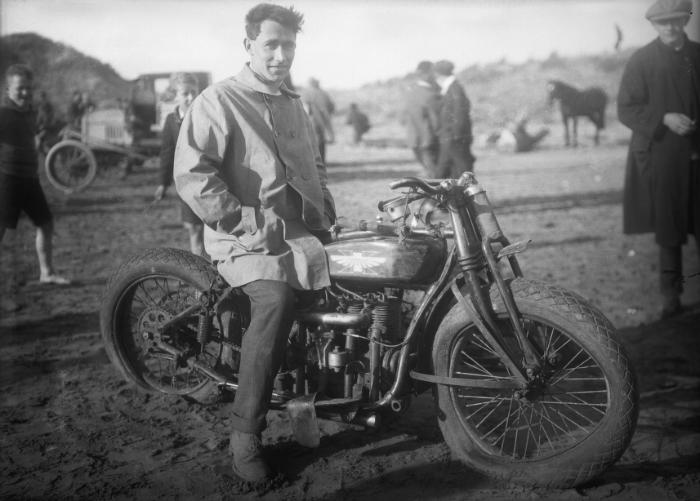
An acknowledgement of a true vintage racer would be this rider and his 4 cylinder Henderson. Not everybody wanted to race their bikes but this guy was keen, he would have had to have been to want to race such an expensive motorcycle like a Henderson 4, even in this stripped down condition. The rider is unknown but is still smiling despite the ‘off’. Note both front and rear tyres have rolled off their rims, and the right hand side handle bar is broken off and lying on top of the tank, whether it broke and caused the crash or broke due to the crash who knows. Love the piston on top of the petrol tank, not sure what its function is but it is too big to have come out of the engine. Photo Courtesy of the Turnbull Library Ref Turnbull EP-0849-1-G
As for the weekend itself it was, as usual, great. Despite the poor weather conditions for Friday, which resulted in some riders leaving their machines in their tents due to slippery nature of the track Saturday did fine up a little bit in the afternoon. Except for the sidecars who numbers seem to be growing each year (must be the exciting racing that it presents) the general entries appeared to be down (don’t know the official count). Whether it was due to the new online entry system, the actual weather itself, or conflicting dates with other events who knows. This of course reflected in entries for the vintage and pre war classes with only 5 vintage (pre 1931) and 19 pre war entires. It would be great to see a few more vintage machines out there, they don’t have to be the real deal, just anything that is oil tight, pre 1931 and with a handchange gearbox. If you are thinking about it but am unsure contact us as we may be able to help. As they say Go on give it a go. You know you want to really. Remember riding and racing are just inches apart and what safer place to ride a vintage bike than on a race track (at least all the bikes are going in the same direction, and there are no cars or dogs).
Spectator wise the interest was there, especially for Sunday. A good turnout of road bikes both modern and old, and the Post Classic Racing lads once again had a good display of their machines and the lunchtime ride by of the american 4’s was most entertaining.
Personally, even though our weekend was not a success it has rekindled Knobsta’s interest and now he is keen to get back out there on his pre war gad-a-bout ( it is a bit slow to be regarded as a racing thoroughbreed, but as he says somebody has to come last)
We did our best to compile a theatre of photographs for those of you who were unable to get to the racing. They are all of static displays and due to the white reflective background of the marquee some were quite difficult to photograph, especially the Militaire. There are no action shots of the vintage and pre war bikes racing as we were busy trying to remedy our own racer problems. Racing and photographing definitely makes for a busy weekend. Click on the image to see the full size photgraph.
.
.
.
.
.
.
.
.
.
.
.
.
.
.
.
.
.
.
.
.
.
.
.
.
.
.
.
.
.
.
.
.
.
.
.
.
.
.
.
.
The Display This drew a lot of attention over the weekend. The machines are mainly american 4 cylinder however there were a couple of Danish made Nimbuses (or should that be Nimbi?) and a very early unrestored Belgium made FN. It just goes to show that people are definitely interested in the past. Some of the expressions on peoples faces quite clearly told of their disbelief that riders would have ridden thousands of miles on these machines. My favourite would definitely have to be Spyders unrestored Henderson 4 and farm sidecar. With respect to the motorcycles history Spyder has done his best to retain the originality and not to restore the bike. Others might think differently, however to restore it to its 1917 catalogue standard would remove any trace of its true history, a trait so common with vintage motor vehicle owners today.
.
.
.
.
.
.
.
.
The Militaire one of the more unique motorcycles on display with its car like engine and gearbox design, retractable outrigger wheels on the rear, wooden spoke wheels and front centre hub steering. Made in America but not a great success this one was on loan for the weekend from Thomsons Motorcycle Museum of Kairanga, Palmerston North. For an interesting local story on an FN engine click here.
.
.
.
.
.
.
.
.
A very nice modified SW Douglas from the late 1920s. Originally designed as the DT (Dirt Track) in 500 and 600 capacities Douglas manufactured 1300 of these between 1928 and 1929 to be used on the newly emerging speedway or cinders racing. The DT was formidable, winning many titles and paved the way to sliding with the early unique ‘trailing leg’ riding style. However by 1930 other manufacturers were coming on board with their own designs built around shorter wheelbase single cylinder machines which proved a lot quicker in the corners. Douglas DTs disappeaeed overnight and reappeared as the SW fitted with brakes to be used on the road, however with no lighting available (except for acetylene) and no kick start they were not a great sales success. They have been raced successfully in the UK since the 1960s as modified sprinters reaching speeds up to 140mph. Great to see it on display.
Todds exceptional 1929 AJS M10SR. A very rare machine with an interesting history. Hopefully Barnstormers can bring you more on this brute-ish machine later on in the year.
Todd and his pit crew chief performing some pre race adjustments.
.
.
.
.
.
.
.
.
1928 350 TT Excelsior with later modified foot change gearbox.
Some of the stories that are created over the weekend and change as time goes by is how fast the racers were going, who passed who, and who finished where. You know how it goes tall stories mixed with alcohol, fading memories and time become even taller stories of daring do! Well for the last few years the Classic Racing Register have utilized the services of Mark-Time and with modern technology accurately record lap times and race positions and post them at the end of each race for competitors and spectators to see. They are complete with racers, lap times, race positioning and weather and track conditions. Click on the races below to see who came where, when. Should put a stop to alcohol crazed geriatics arguing over who was the best (not that we drink really!)
Click on the following links to see how the races finished Saturday – Race 12, Race 19, Sunday Race 44, Race 52.
If you are interested in what the other racers lap times were (sidecars, clubmans, etc) click here.
An interesting race bike from a festival a few years ago was the Walter. This was built up in the late 1990s as an early replica of a fixed speed belt drive special and displayed its name of its creator Steve Walter. Other than the small front drum brake (installed as a safety precaution) it was mainly assembled from 1910s parts JAP engine complete with hand oiler and Bosch magneto, and early flat tank style frame. Performance wise it wasn’t a rubber burning success but then again 95 years ago nothing was. Last seen being pushed back to the pits with a broken drive belt slung over the riders shoulder whilst he waved feveroushly to the applauding crowd. And that’s what it is all about.
.
.
.
.
.
.
.
The Walter.
For additional photos of classic racing at Pukekohe including the more modern classic classes click here to go to Yahoo Flicker for Spooky21 and his photo gallery.

